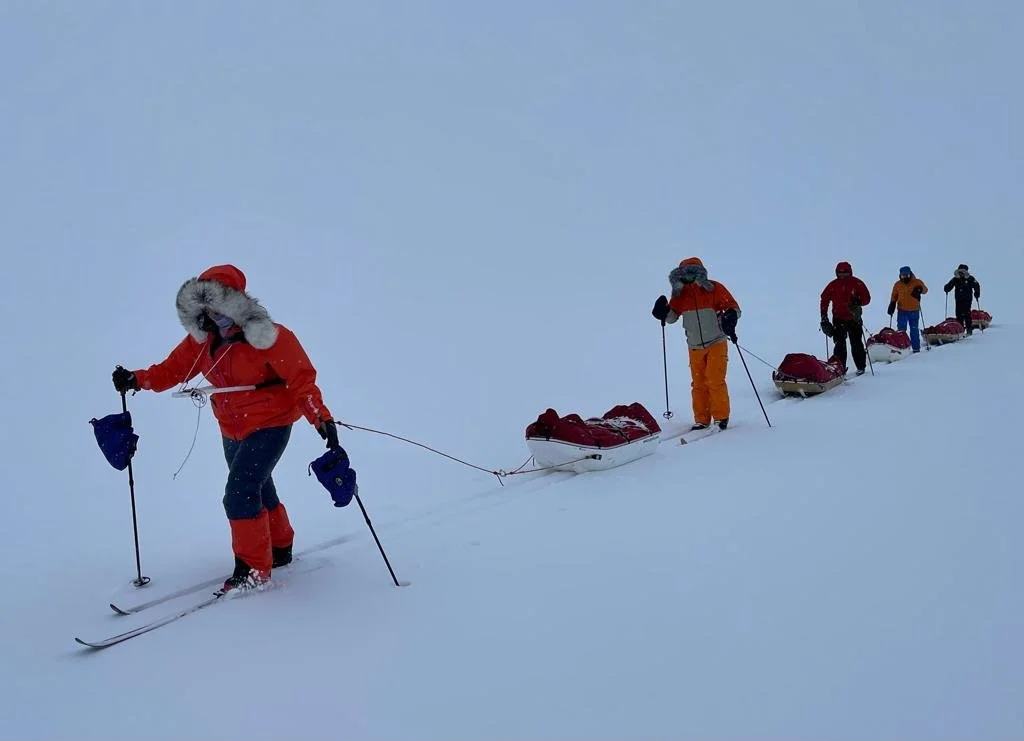Course Overview
Run out of the remote mountain village of Finse at the heart of the spectacular Hardangervidda plateau in Norway, the purpose of the Polar Training Course is to prepare individuals for participation in a challenging polar expedition such as skiing long distance or an unguided last degree to the South or North Pole or crossing the Greenland Icecap.
DOWNLOAD COURSE BROCHURE
Itinerary
Week One
Morning classroom sessions, afternoon practical outdoor sessions, learning to cross-country ski, evening lectures.
Week Two
A remote and highly challenging 6-day mini expedition on the Hardangervidda Plateau. This is a very physical week, which requires good levels of strength and endurance fitness. Before arriving on the course you should be satisfied that you have the physical ability to pull a 40kg sled up and down hills at a gentle but consistent pace for 8 hours a day for 6 days straight.
CAVEAT
If by the end of week one any student has been assessed by the instructors to be absolutely unable to sustain the appropriate level of activity, they may not be able to continue and partake in week two.
“I never thought I’d learn so much. It’s by far the best outdoor workshop that I ever attended. Totally focused in preparing us to go safe and with all the knowledge to have a enjoyable expedition, instead of just surviving a South Pole trip.”
Course Topics Covered
Clothing
The correct use of layers and how to combine base layers, mid layers and outer layers to best effect in an extreme working environment; a close look at the different types of clothing and materials available; hands and face management; socks; vapor barrier footwear; using your clothing, venting and temperature control; footwear, boots and bindings; skis, skins, fish scales; snowshoes and camp footwear.
Pulks
Different types; runner technology; packing and weight distribution; covers and bags; trace options; harnesses.
Tents
Different styles, type, designs and brands of tents Desirable features – what to look for.
Preparing tents for polar use
Camping
Orientation of camp for weather, drifting and cooking; erecting and protecting camp in extreme conditions; bear security; making your tent into a practical working space; preparing toilets; allocating tasks to the team; solar panels; efficient camping; camping etiquette; sleeping bags, brands, features, uses; getting a good night’s sleep, hot water bottles, drying clothing and equipment as you sleep; mats, Thermarests, insulation from the ground, vapor barrier bags; field repairs.
Cooking
Safety for cooking inside a tent; carbon monoxide management; stove types; stove boards; fuel types, usage and management; stove and pump maintenance; using snow for water; pots, kettles and pans; heat exchangers and aluminum wraps; managing steam; washing up; packing a tent kitchen bag
Food and Eating
Nutritional and calorific intake and breakdown by bodyweight; hydration; recovery supplements; electrolytes; effective food intake on the trail; freeze dried food - brands and varieties and nutritional value; weight loss; managing hunger and dealing with anorexia; weight gain and loss
Health and Hygiene
What to do with hair and beards; washing options; wash bag essentials; teeth and lip care; foot care – dealing with blisters and pressure sores; finger splits; vitamins and supplements; polar coughing; sun protection; snow blindness; preventing and dealing with frostbite; emotional preparation and management; carbon monoxide poisoning; medical kit contents; pain management; accessing remote medical advice
Training and Physical Preparation
General fitness; tire pulling; building endurance; weight gain; mental preparation
Travelling In A Polar Environment
Finding the right travel schedule; managing breaks; buddy systems; managing pace; working as a team; keeping your head in the game; managing crevasse, moulin and river situations; swimming in the Arctic Ocean; judging and travelling on sea ice; tackling large obstacles
Navigation
Planning your route; Charts, latitude, longitude and the magnetic poles; GPS use; compass use; natural navigation resources, sun, wind, surface features, clouds; navigating in zero visibility; working together.
Weather
Overview of weather systems and forces in the main polar regions; managing cold; managing wind
managing white outs; sun dogs and auroras; clouds and what they mean; temperature variations
Environmental Issues
A brief overview of the Antarctic Treaty and the rules that govern our behavior there; a look at the equivalent lack of regulation elsewhere; jettisoning of equipment in the Arctic; keeping our environment pristine; human waste management; garbage management; fuel management
Arctic Differences
Pulks, traces; polar bears, bear fences, firearms; water crossings, kayaks, dry suits, swimming; navigation; darkness; resources.
Access and Permitting
Access options for Antarctica; permitting your activity on Antarctica; access options for the Arctic Ocean; permitting for the Arctic Ocean; access options for Greenland; permitting your activity on Greenland; access and permitting for other icecaps such as in Chile and Iceland
Comms, Power and Electronics
GPS; satellite phones; InReaches; Starlink; solar charging; batteries; iPhones; laptops; options for blogging and sending data; cameras; sched calls and communication with a base person.
Emergency and Evacuation Planning
Expedition risk assessment and creating an emergency plan; insurance; evacuation options and issues in the different polar environments; international search and rescue agreements; appointing a remote emergency coordinator; firearms.

